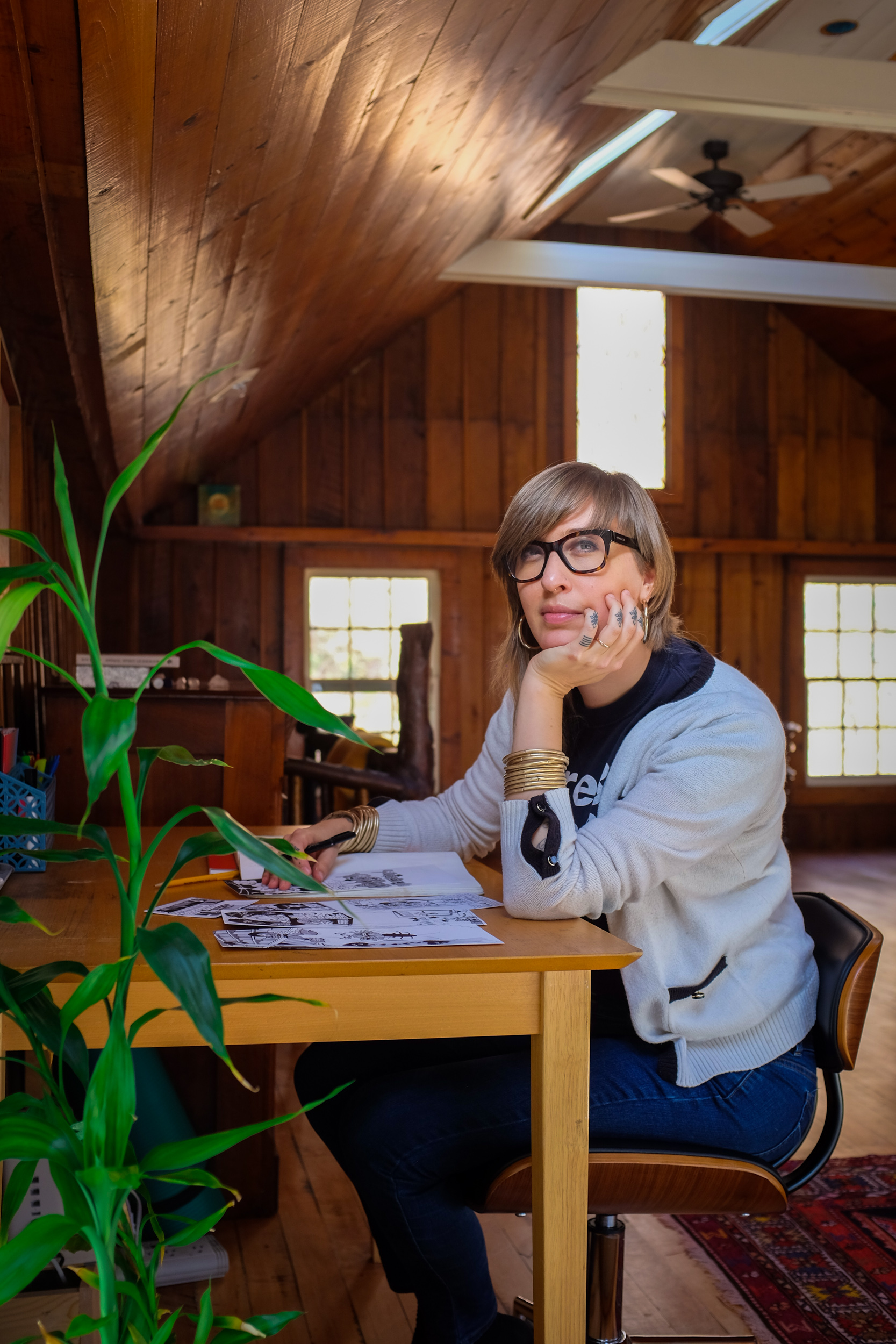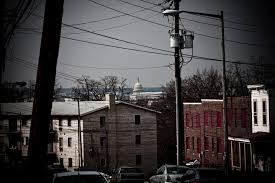Caits Meissner is the Prison and Justice Writing Program Director at PEN America, educator, poet and artist. She has worked with over 50 organizations and taught within prisons, classrooms, and the online community. During the book tour for her poetry collection Let it Die Hungry, Caits held workshops and readings with currently and formerly incarcerated writers. Caits’ latest projects include Pep Talks For Broke(n) People, a DIY comix poetry zine, and New York Strange, a comix vignette series featured in the Hobart journal.
Carissa: Let’s talk about your creative writing workbook, Reaching, that is designed for prison classrooms. How did it come about?
Caits: In 2016, I had a book come out with a small press and I was not very excited about a normal tour with the seven people in the library [laughs] so I thought, “What can I do to make this meaningful?” At that point I had been teaching in prisons for a long time and I decided to do a parallel book tour: wherever I went for a reading I’d visit a prison to do either a free workshop and/or a collaborative reading. The people in the workshop would then read to a larger audience of folks who were incarcerated in that prison. This only happened a few times because it was hard to coordinate, but it was satisfying. Often I found that while thankful for my visit, what other incarcerated people really wanted to see and celebrate was their peers. I visited about 12 or 14 prisons, jails or re-entry programs across the country and I grappled with what it means to visit a prison, or to visit any community, and do a one-off workshop and then leave? Prison, of course, takes on a different level of importance because the taste of the outside world is very welcome to break up the monotony of being restricted and exiled from society. But I also asked myself, what is a gift I can give to the folks I work with to continue their practice? So, I applied for a couple small grants to create this book, Reaching. ‘Reaching in and reaching out’ is the theme of it; reaching in with personal work and reaching out by writing about the world, maybe not writing about yourself. After I sent about 200 copies back to each person I worked with in the prisons, I then made it online for free. This book was made exclusively to speak to people in prison, but it really can be used by anybody.
Carissa: You also launched the #GrowFierce community back in 2012 which ran until 2015. This was a writing curriculum that supported over 500 women worldwide.
Caits: Yes, for about two years I had an online course called “Digging Deep, Facing Self,” a cheesy title if you ask me now, but that’s what it was called at the time! It was a 30-day online course, with daily content and engagement. People did pay to take it, although privately, many were subsidized with the scholarships. It was designed with concepts of healing the self and growing “bold.” Among many others, there were prompts about body image, writing a love letter to yourself, and a prompt addressing jealousy between women, and how to flip that into praise. It had an arc. It was about four or five days per week of writing prompts and then a lot of interactivity in the course community. By the end, it had become such an involved process that we gave a survey where people would say what identities were important to them to be in community with, and we would attempt to pair and match along these lines, in order to offer a more supported experience.
The “bold steps”– for example, a Sunday exercise in the course–were designed to get people in community with others. These included putting your poem draft online and inviting people to read it or send it to five people and get feedback. We also were able to create digital anthologies at the end of course. Everyone could submit two poems—and these were often the first publications for a lot of the women. Then we organized a reading series at Bluestockings feminist bookstore to celebrate the anthology. We would invite women who were local to read, and we also invited more established women poets to read some of their own work, as well as read pieces from women who were not in New York City, but wanted to participate. We would film this and put it online. This is a process we use to stage the work of writers in prison at PEN America, as well—writers who stand in for their peers who cannot be present.
I went to Malaysia on a state-sponsored tour with the curriculum that one of my students arranged. She wanted to bring it to her community, which was sort of unbelievable. Then I also started to teach that curriculum in Sadie Nash Leadership Project for Young Women, Rikers Island with teens and in Bedford Hills women’s prison upstate.
Carissa: What are some of the biggest challenges you’ve faced when teaching your students?
Caits: I think a lot of challenges with students revolve around two things: confidence and ability. Not that students don’t have the ability to grow or shape their work, but maybe they haven’t had the opportunity yet to see themselves as a “successful writer.” Maybe they haven’t had the right exercise, the right prompt, read the right books to make storytelling an interesting activity, or had the chance to see themselves reflected in the pages. Or maybe they haven’t developed the confidence that comes when somebody has praised your writing. The fear of not being good enough can interrupt a young person before they even get a few words on the page.
I find the biggest challenge is always the hook. What is going to make a diverse body of students inspired enough to think there is value and worth in reading and writing? How do we celebrate the successes and how do we pull out what’s working without being false or overly congratulatory or misleading—but really look at what we value? There’s so much emphasis on valuing what’s right in different subjects and school settings, rather than uplifting curiosity and creative engagement as valuable processes on their own.I also often found myself combating a sense of apathy that arrives when students are not exposed to content that speaks to them. Where am I in this work?

Carissa: Interesting. Can you give any examples of techniques you’ve used in the classroom to overcome these challenges?
Caits: A lot of low stakes activities is where it’s at. I was often teaching courses that were designed as “electives” but students didn’t really choose them, or they were hustled into the class without a choice. Instead they were like, “Oh, I’m here but I don’t want to be here,” so the motivation often became the good grade. Many students were not already turned on to writing.
I do a lot of scaffolding with my prompts, and I actually do it with my accomplished writers, too. I think there’s value for any writer at any stage to not just be confronted with a blank page in a workshop or classroom setting, but being offered various entry points. Also, bringing in a wide array of poets (when I’m thinking about teaching a poetry class) into the classroom–diverse voices, identities and approaches. Poets whose work is more accessible, as well as more rigorous material. I’ve seen educators never bring challenging material in because they automatically think it won’t be of interest to their students, and I think that’s a shame. I think it’s important — what you bring in the room, and to express what excites you personally, while allowing students to surprise you in what they’re drawn to. The possibility of mentorship is rooted in the educator’s passion being expressed, and in turn being interested in the student’s passion, questions and struggles. Many of us have that important figure in our life—where I may not have picked up that book otherwise, but because someone I have a relationship with loved it, I became interested, and it changed me.
I think it’s important — what you bring in the room, and to express what excites you personally, while allowing students to surprise you in what they’re drawn to.
Carissa: What about writing and teaching techniques you’ve come across while working as a consultant?
Caits: I did some consulting with the Community-Word Project on inspiring students to write, and some of those exercises were amazing–though many I’ve gathered over the years, and am unsure who created them. A game of writing-exercise telephone! One that I remember clearly involved interactive group generation. Take pieces of chart paper and divide the room into groups of three to five. Ask someone to write A-Z on the paper and then, following a certain theme, such as musical instruments or— more abstractly— things that grow, task students with writing what as many things that they can think of under each letter (Tambourine, triangle, tuba, trumpet!). Though I frame it as a timed competition, the end result is, and reward, is in discovering all of this new material for writing. And then we did a writing prompt that incorporated something from each list, so now everybody has a community sourced bank of material to go to. The activity brings a sense of community spirit, takes some pressure off, and will hopefully spurs further memories and ideas. It also gets us off the individual page and into a process that’s really embodied.
Carissa: That’s exciting. And what are we seeing “on the page” from students these days? Any common themes?
Caits: Yes. First of all, love poems with teens. Always. And it’s actually a great hook to get people writing. I love a good love poem and I’m never afraid of that. I also see young people want to write about their lives. This is not always the case, of course. I obviously do a lot of work in prisons with my job at PEN America and I’ve taught in prisons for a long time, and I’ve found the opposite at times: not everyone in prison wants to write about prison all the time—especially more accomplished writers. It can feel pigeonholing. I do think that young people are looking through the lens of a growing self, and are really interested in the world around them and the hardships they experience and see. It can be cliché to say so, but I think many have used the page as a way to express and deal with emotion, and it is a positive outlet.
Carissa: You sound really excited when talking about students getting their words on the page. What are some other joys of teaching for you?
Caits: So many! First and foremost, I think being in community as a writer, even if you’re “the leader,” is really an inspiring and necessary part of the writing experience. It’s one that we don’t always make time for or consider because writing is a very solitary activity. Even if I didn’t have an active writing group, I could go to a classroom and lead activities and hear the share outs. The joy of hearing someone read a phenomenal poem or phenomenal line, it just gets my juices going. It’s very exciting. The process is kind of miraculous, especially when you witness a student who was not previously excited about writing, or a student who is just coming into their identity as a writer and watching their profound hunger to write something great. I remember when I was starting out as a writer, I’d be like ‘listen to my new poem’ to everyone all the time and that feeling often fades the further you get into the craft, the more you publish, and the more you’re into the world of professional writing. Teaching brings you back to that original experience in a really exciting way.
Just thinking about my history of teaching, I’m very happy with and proud of the work I do to support writers and mentors in different ways. The classroom is so ripe with possibility and when I see educators do interesting things in their classroom, with young people especially, I’m just so blown open and inspired.
Carissa: Speaking of people doing interesting things, PEN America has it’s unique Mentoring Program that’s definitely worth chatting about. Can you tell us more?
Caits: The mentor program has about 300 participants with working writers on the outside mentoring writers on the inside. The assumption, of course, is that writers on the inside are in need of mentorship and frankly, we all are! I had an instinct that we could start to break open that dynamic and start to move our mentorship program into a more multi-directional process. We had an opportunity to partner with the National Novel Writing Month (NaNoWriMo) organization this year. The idea I had when they came to us was to use this as a pilot to think about mentorship differently. We invited four of our most talented and rigorous fiction writers who are currently incarcerated, and who have won in our contests and who we have a relationship with, to be peer facilitators to a group of men writers where they are incarcerated. Each of them had about five other men who they were working with during this 30-day novel writing process using the National Writing Novel Month’s workbook. We had touch points where they would share reflections and project descriptions. We were posting excerpts on our blog and inviting other people participating in National Novel Writing Month to send feedback through a form.
We also had a couple of writers, including Jennifer Egan and Sergio de la Pava write pep talks, which National Novel Writing Month does, but these writers wrote specifically to our writers in prison. We then shared it with everyone. And their advice was completely translatable and, as it turns out, it did not matter if the pep talk was about prison or not. That’s the whole point of the project, our work, my original workbook—writers in prison are just writers. Our goal was to help those writers behind the walls communicate with the larger national movement that was happening in the world they are separate from. It was wildly successful and beautiful. It is now something we are going to be able to use to expand that model and figure out what that looks like on a more on-going basis.
Carissa Chesanek spoke with Caits Meissner over the phone in December 2019.



One response to “Conquering the Page”
[…] Follow Meissner’s monthly comix vignette series New York Strange in Hobart. Purchase Meissner’s debut hybrid poetry book Let It Die Hungry. Read an interview with Meissner about her justice work in Teachers & Writers Magazine. […]